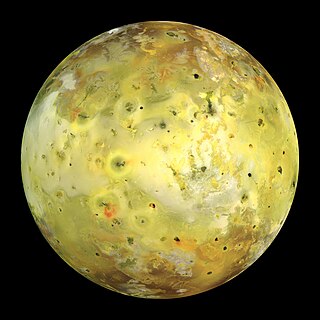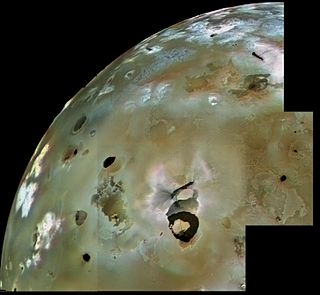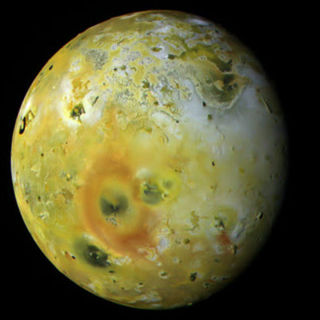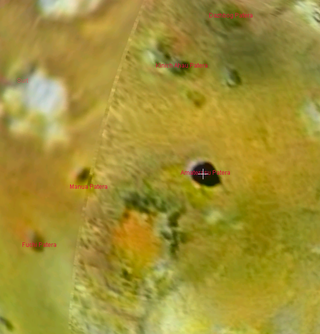
Io, or Jupiter I, is the innermost and second-smallest of the four Galilean moons of the planet Jupiter. Slightly larger than Earth's moon, Io is the fourth-largest moon in the Solar System, has the highest density of any moon, the strongest surface gravity of any moon, and the lowest amount of water by atomic ratio of any known astronomical object in the Solar System. It was discovered in 1610 by Galileo Galilei and was named after the mythological character Io, a priestess of Hera who became one of Zeus's lovers.

Loki Patera is the largest volcanic depression on Jupiter's moon Io, 202 kilometres (126 mi) in diameter. It contains an active lava lake, with an episodically overturning crust. The level of activity seen is similar to a superfast spreading mid-ocean ridge on Earth. It is the largest volcano on Io, producing about 10% of Io’s total thermal emission. Temperature measurements of thermal emission at Loki Patera taken by Voyager 1's Infrared Interferometer Spectrometer and Radiometer (IRIS) instrument were consistent with sulfur volcanism.

Pele is an active volcano on the surface of Jupiter's moon Io. It is located on Io's trailing hemisphere at 18.7°S 255.3°W. A large, 300-kilometer (190 mi) tall volcanic plume has been observed at Pele by various spacecraft starting with Voyager 1 in 1979, though it has not been persistent. The discovery of the Pele plume on March 8, 1979 confirmed the existence of active volcanism on Io. The plume is associated with a lava lake at the northern end of the mountain Danube Planum. Pele is also notable for a persistent, large red ring circling the volcano resulting from sulfurous fallout from the volcanic plume.

Volcanism on Io, a moon of Jupiter, is represented by the presence of volcanoes, volcanic pits and lava flows on the surface. Io's volcanic activity was discovered in 1979 by Linda Morabito, an imaging scientist working on Voyager 1. Observations of Io by passing spacecraft and Earth-based astronomers have revealed more than 150 active volcanoes. As of 2024, up to 400 such volcanoes are predicted to exist based on these observations. Io's volcanism makes the satellite one of only four known currently volcanically or cryovolcanically active worlds in the Solar System

Reiden Patera is a volcanic feature on Jupiter's moon Io. It was first detected by the Galileo SSI Team during the spacecraft Galileo's first orbit around Jupiter, initially detected as a hotspot. It was once thought that the activity there had stopped or waned below the limits of the spacecraft's Solid State Imager or Near-Infrared Mapping Spectrometer. However, it was noticed in 2002 that Reiden Patera has darkened considerably since the 24th orbit of Galileo. It has been spouting bright red pyroclastic deposits of its own. It is located at 13.4°S 235.45°W and is 70 kilometers in diameter. It is named after a Japanese thunder god. Asha Patera can be found to the east, and Kami-Nari Patera can be found to the north.

Amaterasu Patera is a patera, a complex crater with scalloped edges, on Jupiter's moon Io. It is one of the darkest features on Io, and the measurement of its thermal spectrum helped to support an anticorrelation between albedo and temperature for Ionian hotspots. The feature has darkened further since the first orbit around Jupiter by the Galileo spacecraft. It is 100 kilometers in diameter and located at 38.1°N 306.5°W. It was named after the Japanese sun goddess Amaterasu. To the north are Kinich Ahau Patera and Dazhbog Patera, and to the west are Manua Patera and Fuchi Patera.

Asha Patera is a patera, or a complex crater with scalloped edges, on Jupiter's moon Io. It is approximately 108 kilometers in diameter and located at 8.84°S 225.69°W. It is named after asha, the Zoroastrian principle of Truth. Its name was adopted by the International Astronomical Union in 1979. Reiden Patera and Kami-Nari Patera can both be found to the west.

Fuchi Patera is a patera, or a complex crater with scalloped edges, on Jupiter's moon Io. It is approximately 66 kilometers in diameter and is located at 28.4°N 327.6°W. It is named after the Ainu fire goddess, Kamuy Fuchi. Its name was adopted by the International Astronomical Union in 1979. Manua Patera is located north-northeast, and Amaterasu Patera is located northeast.

Kinich Ahau Patera is a patera, or a complex crater with scalloped edges, on Jupiter's moon Io. It is about 45 kilometers in diameter and is located at 49.35°N 310.25°W. It is named after the Mayan sun god Kinich Ahau. Dazhbog Patera is located northeast, Amaterasu Patera is located south-southeast, and Manua Patera can be found southwest.

Monan Patera is a patera, or a complex crater with scalloped edges, on Jupiter's moon Io. It is about 137 kilometers in diameter and is located at 19.82°N 104.81°W. It is named after Monan, a god in Brazilian mythology that destroyed the world with fire and floods. Its name was adopted by the International Astronomical Union in 1997.

Ah Peku Patera is a patera, or a complex crater with scalloped edges, on Jupiter's moon Io. It is 85 kilometers in diameter and is located at 10.3°N 107°W. It is named after the Mayan thunder god Ah Peku. Its name was adopted by the International Astronomical Union in 2006. Ah Peku Patera is located on the south end of Monan Mons, north of which is Monan Patera. The eruptive centers Amirani and Maui can be found northwest, as well as Maui Patera. Gish Bar Patera is located toward the northeast. Ah Peku Patera was first detected by the spacecraft Galileo's Solid State Imager and Near-Infrared Mapping Spectrometer. It is considered an active hot spot.

Gish Bar Patera is a patera, or a complex crater with scalloped edges, on Jupiter's moon Io. It is 106.3 by 115.0 kilometers and 9,600 km2 in area. It is located at 16.18°N 90.26°W. It is named after the Babylonian sun god Gish Bar. Its name was approved by the International Astronomical Union in 1997. It is located at the southern base of Gish Bar Mons, an 11-kilometer-high mountain. To the northeast is Skythia Mons, and to the east is Monan Mons, at the north and south ends of which are Monan Patera and Ah Peku Patera.

Maui Patera is a patera, or a complex crater with scalloped edges, on Jupiter's moon Io. It is about 38 kilometers in diameter and is located at 16.61°N 124.23°W. It is named after Māui, a Hawaiian demigod that sought fire from Mafuike. Its name was approved by the International Astronomical Union in 1979. It is located southwest of the eruptive center Maui, south of Euxine Mons, and southwest of the volcano Amirani. Due east are Monan Patera, Monan Mons, and Ah Peku Patera.

Babbar Patera is a patera, or a complex crater with scalloped edges, on Jupiter's moon Io. It is about 86 kilometers in diameter and is located at 39.8°S 272°W. It is named after a Sumerian sun god, and its name was approved by the International Astronomical Union in 1979. Some scarps near Babbar Patera may represent faults. Immediately south of Babbar Patera is the plateau Lyrcea Planum, and further south is Svarog Patera. To the east is the mountain Egypt Mons.

Svarog Patera is a patera, or a complex crater with scalloped edges, on Jupiter's moon Io. It is 124 kilometers in diameter and is located at 48.66°S 265.74°W. It is named after the Russian smith god Svarog. Its name was approved by the International Astronomical Union in 1979. Svarog Patera is a Voyager spacecraft-detected hot spot. North of Svarog Patera is Lyrcea Planum, north of which is Babbar Patera. To the south is Silpium Mons, and to the east is Hermes Mensa. To the southeast are Pyerun Patera and Epaphus Mensa.

Pyerun Patera is a patera, or a complex crater with scalloped edges, on Jupiter's moon Io. It is about 57 kilometers in diameter and is located at 55.65°S 251.06°W. It is named after the Slavonic god of thunder, Pyerun. The name was adopted by the International Astronomical Union in 1985. West of Pyerun Patera is Mithra Patera, and to the east is the mesa Epaphus Mensa. To the northeast is Epaphus Mensa, and to the northwest are the mountain Silpium Mons and Svarog Patera.

Mithra Patera is a patera, or a complex crater with scalloped edges, on Jupiter's moon Io. It is about 34 kilometers in diameter and is located at 59.04°S 266.48°W. It is named after the Persian god of light, Mithra. Its name was adopted by the International Astronomical Union in 1985. To the north is Silpian Mons, and to the east is Pyerun Patera. Located southwest is Viracocha Patera.

Egypt Mons is a mountain on Jupiter's moon Io. It is 10 kilometers in height, making it the 11th tallest mountain on Io, and taller than Mount Everest. Although the U.S. Geological Survey gives a diameter of 193.7 kilometers, the Io Mountain Database gives a length of 133.8 kilometers and a width of 146.0 kilometers. It is a Flatiron Massif mountain, meaning it has a rugged, irregular appearance and complex surface morphology. It is 9792 km2 in area and its center located at 41.49°S 257.6°W. It has a steep, north-facing scarp. Egypt Mons is named for Egypt, because that is the place where Io ended her wanderings in the mythology. Its name was adopted by the International Astronomical Union in 1997. To the northwest is Babbar Patera, and southeast is Hermes Mensa. Svarog Patera can be found to the southwest.

Silpium Mons is a mountain on Jupiter's moon Io. It is 5.6 kilometers in height, 113 kilometers in length, and 79.7 kilometers in width. It covers an area of 7073 km2. It is a striated ridge, meaning it is an elevated structure dominated by one or more prominent linear or arcuate rises. It is named after a location in Greece where the mythological Io died of grief. Its name was adopted by the International Astronomical Union in 1979. It is located at 52.71°S 272.34°W, south of Svarog Patera, north of Mithra Patera, and northeast of Viracocha Patera. Its proximity to Svarog and Viracocha Paterae has been suggested to be evidence for a structural relationship between mountains and calderas on Io.

PateraPAT-ər-ə is an irregular crater, or a complex crater with scalloped edges on a celestial body. Paterae can have any origin, although the majority of them were created by volcanism. The term comes from Latin, where it refers to a shallow bowl used in antique cultures.













